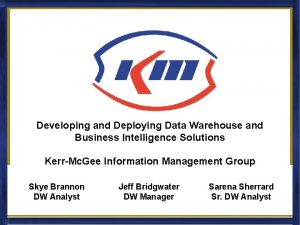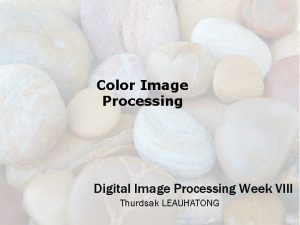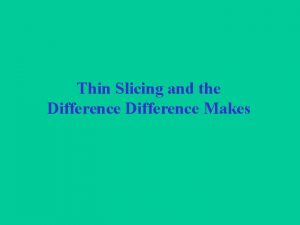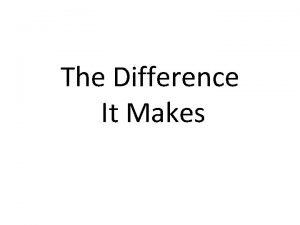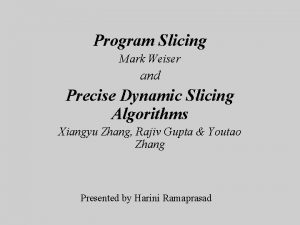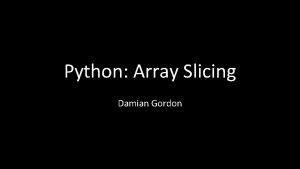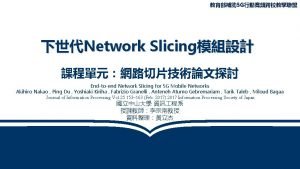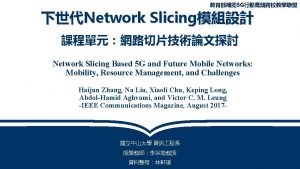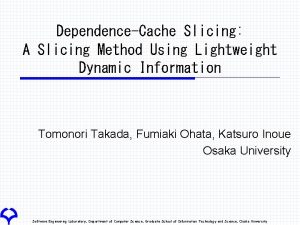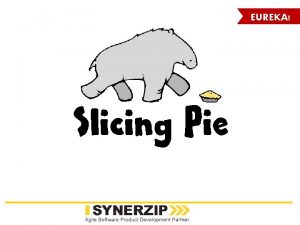Thin Slicing and the Difference Makes Thin Slicing












- Slides: 12

Thin Slicing and the Difference Makes

Thin Slicing John Gottman’s “Love Lab” and SPAFF (for specific affect) By analyzing over 3, 000 couples over 3 decades, Gottman has devised models that provide 95% predictability over couples’ marriage prospects. Like the Getty museum and the Iowa gamblers, Gottman has learned that an enormous amount of valuable data on couples can be gathered quickly and from limited exposure (amidst all the “noise”). - marital DNA is akin to Morse code: a relationship between two people has a “fist” as well…a distinctive signature that arises naturally and automatically; predicting divorce, then, like tracking Morse Code operators, is essentially pattern recognition

Thin Slicing Gottman’s “thin slicing” marriage analysis: - positive sentiment override vs. negative sentiment override - once couples start going down the negative sentiment override, 94% will continue going down it. They start on a bad course and can’t correct it. The 4 Horsemen: defensiveness, stonewalling, criticism, CONTEMPT The Secrets of the Bedroom (in previous eras, it was the “checkbook”): two options to really get to know someone: (1) meet twice a week for a year (lunch, dinner, movie, etc. ) OR (2) drop by the person’s house/dorm room for an hour without warning

Thin Slicing: Samuel Gosling’s “Big 5” Inventory Welcome to the Gosling lab Page … (We study offices and what they say about their occupants. . . but this isn't my office. . . mine was deemed too dull for the photograph!) pp. 34 -37 80 students filled out a brief “Big Five” personality inventory (p. 35) and then had close friends of the 80 students fill out the same questionnaire - strong correlation between the inventory and the questionnaires (not surprising), but what was surprising?

Thin Slicing: Samuel Gosling’s “Big 5” Inventory Dorm room observers weren’t nearly as good as friends in measuring and, thus, predicting an individual’s “extraversion (or introversion)”. They were also less good than an individual’s friends in measuring and predicting how “agreeable” the person was. BUT, and this is what is so interesting (and perhaps disturbing), on the remaining 3 personality dimensions—conscientiousness, emotional stability, and openness to new experiences—the strangers with clipboards who simply analyzed individuals’ rooms outperformed the individuals’ friends in terms of correlating with the individuals’ responses to questions about their personality (e. g. , bookshelves, medicine cabinets, CD racks). Why is this important? All policy-making (college admissions, welfare qualifications, corporate America’s extensive use of and dependence on personality tests for hiring and advancement, etc. ) relies very, very heavily on the PREDICTABILITY of instruments. Coming at individuals “sideways” is often a lot more effective in terms of successfully analyzing them and predicting their behavior, which (again) is the primary objective of public policy: encouraging some types of behavior and discouraging others.

Thin Slicing, Doctors, and Malpractice Suits Ironically, a doctor’s likelihood for being sued has much, much less to do with competence than what? Studies of physicians’ conversations with patients showed a clear pattern or relationship between length and type of conversation and how often (if at all) the physicians had been sued in their careers. New state-level policies aimed at reducing otherwise skyrocketing malpractice insurance prices for doctors: apologizing. The risks are extraordinary, yet research shows that nothing is more effective in reducing liability than “an authentically offered apology. ” Extreme Honesty policy at Lexington Kentucky VA hospital: the hospital’s average cost of error-related payouts – including settlements and jury verdicts – was only $15, 662, which put the hospital in the bottom quarter of 35 local hospitals. “Apology is psychologically expected when a wrong has been done. ”

The Wisdom of Crowds: The Difference Makes (DIVERSITY) In our politically-correct world, “diversity” has become such a sloppy buzzword that it’s easy to miss its actual importance: The angle from the sun indicates direction. The duration of the waggle part of the dance signifies the distance. Approximately 1 second of dance = 1 km distance.

The Wisdom of Crowds: The Difference Makes (DIVERSITY) Diverse innovation is absolutely key to continued economic growth. . . In each of these eras, the early days of a business or area of industry are characterized by a profusion of alternatives, many of them dramatically different from each other in design and technology. At the end of the era, a few players are left standing and in control of most of the market.

The Wisdom of Crowds: The Difference Makes (DIVERSITY) Scott Page’s research on problem-solving: groups of “experts/smart people” regularly under-perform more random, eclectic groups that still have some “experts/smart people” but also some naïve individuals and “non-experts” Why? Several reasons, not the least of which his that “experts” don’t normally hedge as much as they should or rate (calibrate) the likelihood of their predictions (except for weathermen and bridge players). Experts usually have the same info. “Experts” rarely know how often they are wrong: 1984 -1999: 90% of mutual-fund managers under-performed the Wilshire 5000 Index (catalyst for “index” investing” Yet “pooling” the advice and predictions of different experts tends to identify error and cancel it out much more often than single, individual “expert” decision-making. A risk: “groupthink”

Irving Janis’ “Groupthink” Shows the risks of group decision-making when group is homogenous (not diverse) and contribution to the deliberation is not on an individual basis. Bay of Pigs fiasco Solomon Asch’s “social pressure & perception” experiment (e. g. , elevators)


Other Examples of “Groupthink” - professors in the academy - reconstruction of Iraq (not the invasion/war, which was a huge success) - 1980 Iran hostage rescue - dot-com bubble (pets. com, boo. com, webvan. com) - real estate bubble today?
